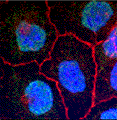Biochemistry, Department of
Document Type
Article
Date of this Version
2011
Citation
THE JOURNAL OF BIOLOGICAL CHEMISTRY VOL. 286, NO. 19, pp. 17005–17014, May 13, 2011
Abstract
Naked mole rat (MR) Heterocephalus glaber is a rodent model of delayed aging because of its unusually long life span (>28 years). It is also not known to develop cancer. In the current work, tissue imaging by x-ray fluorescence microscopy and direct analyses of trace elements revealed low levels of selenium in the MR liver and kidney, whereas MR and mouse brains had similar selenium levels. This effect was not explained by uniform selenium deficiency because methionine sulfoxide reductase activities were similar in mice and MR. However, glutathione peroxidase activity was an order of magnitude lower inMRliver and kidney than in mouse tissues. In addition, metabolic labeling of MR cells with 75Se revealed a loss of the abundant glutathione peroxidase 1 (GPx1) band, whereas other selenoproteins were preserved. To characterize theMRselenoproteome, we sequenced its liver transcriptome. Gene reconstruction revealed standard selenoprotein sequences except for GPx1, which had an early stop codon, and SelP, which had low selenocysteine content. When expressed inHEK293cells,MRGPx1waspresent in low levels,and its expression could be rescued neither by removing the early stop codon nor by replacing its SECIS element. In addition, GPx1 mRNAwas present in lower levels inMRliver than in mouse liver. To determine if GPx1 deficiency could account for the reduced selenium content, we analyzed GPx1 knock-out mice and found reduced selenium levels in their livers and kidneys. Thus, MR is characterized by the reduced utilization of selenium due to a specific defect in GPx1 expression.
Included in
Biochemistry Commons, Biotechnology Commons, Other Biochemistry, Biophysics, and Structural Biology Commons



Comments
US government work